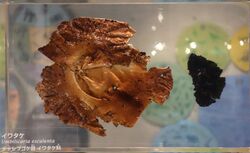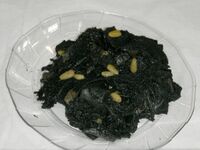Biology:Umbilicaria esculenta
| Umbilicaria esculenta | |
|---|---|

| |
| Scientific classification | |
| Domain: | Eukaryota |
| Kingdom: | Fungi |
| Division: | Ascomycota |
| Class: | Lecanoromycetes |
| Order: | Umbilicariales |
| Family: | Umbilicariaceae |
| Genus: | Umbilicaria |
| Species: | U. esculenta
|
| Binomial name | |
| Umbilicaria esculenta (Miyoshi) Minks (1900)
| |
| Synonyms | |
| |
Umbilicaria esculenta, the rock tripe, is a lichen of the genus Umbilicaria that grows on rocks.
Morphology
Two different types of polysaccharides are known to be the structural components, both a heteroglycan from the fungus and a glucan from the alga.[1] U. esculenta lichens have a thallus attached to the substrate with a central holdfast.[2] The thallus is also heteromerous (parts that are different in quality and number) and fully corticated (has a cortex and bark). Many of the Umbilicaria species are characterized by a veined or rugose thalline surface.[2]
Ecology
Umbilicaria esculenta is a saxicolous lichen; it grows on rocks and is known widely as the "rock tripe". It is usually found on at high altitude in East Asia.[3]
Human uses
Lichens have a history in folk foods. U. esculenta is considered a delicacy where it is eaten in dishes, soups, or in salads.[4] It has been used as starvation food by Native Americans and early settlers.[4]
Gallery
References
- ↑ Sone, Y., Isoda-Johmura, M., & Misaki, A. (1996). Isolation and chemical characterization of polysaccharides from Iwatake, Gyrophora esculenta Miyoshi. Bioscience, biotechnology, and biochemistry, 60(2), 213-215.
- ↑ 2.0 2.1 Watson, R. R. (n.d.). Polyphenols in plants isolation, purification and extract preparation. Academic press, an imprint of Elsevier.
- ↑ Sun, Yanhong, et al. “The Polysaccharide Extracted from Umbilicaria Esculenta Inhibits Proliferation of Melanoma Cells through ROS-Activated Mitochondrial Apoptosis Pathway.” Biological and Pharmaceutical Bulletin, The Pharmaceutical Society of Japan, 1 Jan. 2018, https://www.jstage.jst.go.jp/article/bpb/41/1/41_b17-00562/_html/-char/ja.
- ↑ 4.0 4.1 Zhao, Y., Wang, M., & Xu, B. (2021). A comprehensive review on secondary metabolites and health-promoting effects of edible lichen. Journal of Functional Foods, 80, 104283
Wikidata ☰ Q1316373 entry
 |



